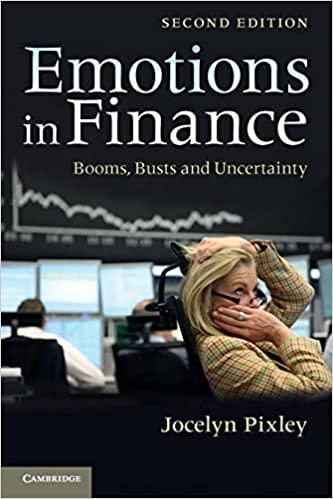Answered step by step
Verified Expert Solution
Question
1 Approved Answer
1. Exhibit 1.1; USE THE INFORMATION BELOW FOR THE FOLLOWING PROBLEM(S) Security Annual Percentage Return U.S. government T-bills 3.04 Long-term government bonds 5.75 Long-term corporate
1. Exhibit 1.1; USE THE INFORMATION BELOW FOR THE FOLLOWING PROBLEM(S) Security Annual Percentage Return U.S. government T-bills 3.04 Long-term government bonds 5.75 Long-term corporate bonds 6.80 Large capitalization common stocks 13.50 Small capitalization common stocks 15.60 The annual rate of inflation is 2%. Refer to Exhibit 1.1. a. What is the real return on long-term corporate bonds? b. What is the real return on T-bills? c. What is the real return on small capitalization stocks? d. What is the real return on large capitalization stocks? 2. Exhibit 1.2; USE THE INFORMATION BELOW FOR THE FOLLOWING PROBLEM(S) Real Returns Investment Real Annual Return Large company stock 6.50% Small capitalization stock 8.60% Long-term corporate bonds 3.60% Long-term government bonds 2.80% U.S. Treasury bills 1.03% The annual rate of inflation is 2.5%. Refer to Exhibit 3.2 a. What is the large company stock nominal return? b. What is the T-bill nominal return? c. What is the long-term Treasury bond nominal return? d. What is the small capitalization stock nominal return? 3. A return series has an arithmetic mean of 12.8% and standard deviation of 7.8%. Assuming the returns are normally distributed what, is the range of returns that an investor would expect to receive 90% of the time? 4. Solve the following; a. A return series has an arithmetic mean of 10.5% and standard deviation of 13%. Assuming the returns are normally distributed what, is the range of returns that an investor would expect to receive 95% of the time? b. What is the 95 percent confidence interval for an investment with an expected return of 9 percent and a standard deviation of 15%? 5. You are trying to decide between a par value corporate bond carrying a coupon rate of 6.25% per year and a par value municipal bond that pays an annual coupon rate of 4.75%. Assuming all other factors are the same and you are in the 28% tax bracket, which bond should you choose and why? 6. What range of returns would an investor expect to achieve 99% of the time on an investment with an expected return of 11% and a standard deviation of 16%? 7. If the nominal return on an investment of common stocks was 11% and inflation was 2.5% annually, what was the real return on common stock? 8. If the real return for corporate bonds was 4% and the inflation rate was 2%, what is the nominal return for corporate bonds? Please Guys anyone can help me?
1. Exhibit 1.1; USE THE INFORMATION BELOW FOR THE FOLLOWING PROBLEM(S)
Security Annual Percentage Return
U.S. government T-bills 3.04
Long-term government bonds 5.75
Long-term corporate bonds 6.80
Large capitalization common stocks 13.50
Small capitalization common stocks 15.60
The annual rate of inflation is 2%.
Refer to Exhibit 1.1.
a. What is the real return on long-term corporate bonds?
b. What is the real return on T-bills?
c. What is the real return on small capitalization stocks?
d. What is the real return on large capitalization stocks?
2. Exhibit 1.2; USE THE INFORMATION BELOW FOR THE FOLLOWING PROBLEM(S)
Real Returns
Investment Real Annual Return
Large company stock 6.50%
Small capitalization stock 8.60%
Long-term corporate bonds 3.60%
Long-term government bonds 2.80%
U.S. Treasury bills 1.03%
The annual rate of inflation is 2.5%.
Refer to Exhibit 3.2
a. What is the large company stock nominal return?
b. What is the T-bill nominal return?
c. What is the long-term Treasury bond nominal return?
d. What is the small capitalization stock nominal return?
3. A return series has an arithmetic mean of 12.8% and standard deviation of 7.8%. Assuming the returns are normally distributed what, is the range of returns that an investor would expect to receive 90% of the time?
4. Solve the following;
a. A return series has an arithmetic mean of 10.5% and standard deviation of 13%. Assuming the returns are normally distributed what, is the range of returns that an investor would expect to receive 95% of the time?
b. What is the 95 percent confidence interval for an investment with an expected return of 9 percent and a standard deviation of 15%?
5. You are trying to decide between a par value corporate bond carrying a coupon rate of 6.25% per year and a par value municipal bond that pays an annual coupon rate of 4.75%. Assuming all other factors are the same and you are in the 28% tax bracket, which bond should you choose and why?
6. What range of returns would an investor expect to achieve 99% of the time on an investment with an expected return of 11% and a standard deviation of 16%?
7. If the nominal return on an investment of common stocks was 11% and inflation was 2.5% annually, what was the real return on common stock?
8. If the real return for corporate bonds was 4% and the inflation rate was 2%, what is the nominal return for corporate bonds?
Please Guys anyone can help me?
Step by Step Solution
There are 3 Steps involved in it
Step: 1

Get Instant Access to Expert-Tailored Solutions
See step-by-step solutions with expert insights and AI powered tools for academic success
Step: 2

Step: 3

Ace Your Homework with AI
Get the answers you need in no time with our AI-driven, step-by-step assistance
Get Started


